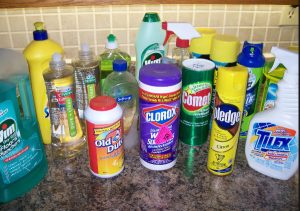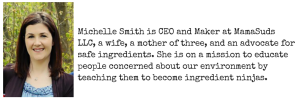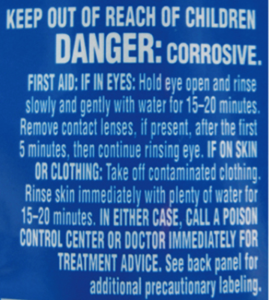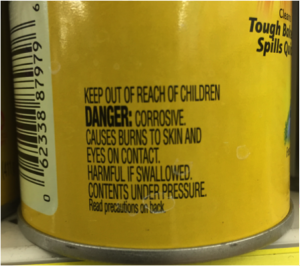
The CleanSuds Blog
Where education and truthful facts are easy to come by.

How to Clean Quartz Countertops
A Guide to Keeping Your Quartz Surfaces Sparkling with MamaSuds
Quartz countertops are a beautiful addition to any kitchen or bathroom. They offer the elegance of natural stone with the durability and low maintenance of engineered surfaces. But just like any other surface in your home, quartz countertops need a little TLC to keep them looking their best. Here’s how you can keep your quartz countertops sparkling clean using MamaSuds products.
Why Quartz Needs Special Care
Quartz is non-porous, which means it resists stains and doesn’t harbor bacteria. However, it can still accumulate dirt, grime, and oils from daily use. While quartz is tough, it can be sensitive to harsh chemicals, so it's important to use the right cleaning products that are gentle yet effective.Step 1: Daily Cleaning with MamaSuds All-Purpose Cleaner
For daily maintenance, you’ll want to keep your countertops free from crumbs, spills, and other residues. MamaSuds All-Purpose Cleaner is perfect for this task. It’s made with non-toxic, biodegradable ingredients, making it safe for your family and the environment.How to Use: Simply spray the MamaSuds All-Purpose Cleaner directly onto the countertop surface. Use a soft, damp cloth to wipe away any debris. For tougher spots, let the cleaner sit for a few minutes before wiping it away. This cleaner is gentle enough for daily use and will leave your quartz looking spotless without any streaks or residue.
Step 2: Deep Cleaning with MamaSuds Castile Soap
Even with regular cleaning, your quartz countertops may occasionally need a deeper clean to remove stubborn grease or stuck-on grime. MamaSuds Castile Soap is up to the task! This versatile, plant-based soap is safe for all surfaces, including quartz.How to Use: Mix a few drops of MamaSuds Castile Soap with warm water in a bowl or bucket. Dampen a soft cloth or sponge with the soapy water and gently scrub the countertop. Focus on any areas with visible stains or buildup. Rinse the cloth or sponge with clean water and wipe down the countertop to remove any soap residue. Finally, dry the surface with a clean towel to restore its shine.
Step 3: Preventing Stains and Damage
While quartz is resistant to most stains, certain substances like wine, coffee, or acidic foods can cause discoloration if left too long. To prevent stains and damage:Wipe Up Spills Immediately: Use the MamaSuds All-Purpose Cleaner to quickly clean up any spills. The faster you act, the less likely the spill will cause a stain.
Use Trivets and Cutting Boards: Protect your countertops from heat and scratches by always using trivets for hot pans and cutting boards for chopping.
Avoid Harsh Chemicals: Stay away from bleach, ammonia, and other abrasive cleaners. MamaSuds products are designed to be gentle on your surfaces while still providing powerful cleaning action.
Step 4: Polishing Your Countertops
To give your quartz countertops that extra shine, you can polish them using a soft cloth. While MamaSuds doesn’t offer a specific polish, the residue-free nature of our products ensures that your countertops will retain their natural luster.How to Use: After cleaning your countertops, buff them with a dry microfiber cloth in a circular motion. This will enhance the natural shine of the quartz and keep your kitchen or bathroom looking luxurious.
Final Thoughts
Cleaning quartz countertops doesn’t have to be a chore, especially when you’re using eco-friendly, non-toxic products like those from MamaSuds. Our All-Purpose Cleaner and Castile Soap provide an effective, safe, and simple solution to keeping your surfaces clean and your home healthy. Plus, by choosing MamaSuds, you’re making a choice that’s good for the planet, too!
So, next time you’re tidying up your kitchen or bathroom, reach for MamaSuds and enjoy the peace of mind that comes with knowing your home is clean, safe, and sparkling.
Ready to give your quartz countertops the care they deserve? [Shop MamaSuds now](#) and discover the difference that truly clean can make!

Clean Your Couch With All Natural Ingredients
• Rubbing alcohol can clean microfiber couches, while a vinegar solution is best for leather.
• For velvet couches, vacuum before brushing, and use a baking soda solution with lemon juice to deep clean and eliminate odor.
• Natural products from MamaSuds will keep furniture looking fresh and healthy without the use of chemicals.

Does Castile Soap Kill Bacteria?
• It does not "kill" germs like an antibacterial does, but rather binds with them and then flushes them out of the home.
• Rubbing alcohol and vinegar are two of the strongest natural antibacterials on the market.
• Trust MamaSuds for affordable Castile soap products to use for safe household cleaning.

Cleaning Tasks That You Should Make a Weekly Occurrence

Having a regular cleaning schedule is one of the best things you can do to make sure your home always looks great and is in good shape. While there are some things you can do infrequently, some household tasks should be taken care of on a weekly basis. Taking care of those tasks regularly will keep your home in prime condition and help you to make an ideal impression.
Kitchen Cleaning
Your kitchen is a hotspot for germs and junk to pile up, and if it isn’t kept clean it can impact the cleanliness of your whole house. Life can get busy and that often results in dishes piling up in the sink, and your counters getting messy. Setting aside time each week to take care of your kitchen cleaning will help you to take care of the mess and prevent things from piling up too much. Kitchn recommends mixing it up with a little music, some games, or rewards to make it more fun for yourself.
Vacuuming
Vacuuming is one of the chores that are most often forgotten, but it can make a big difference. According to Michael’s Professional Carpet Cleaning, you should vacuum the carpet at least once a week to prevent damage. When dirt and grime is allowed to stay in your carpet, it can lead to major problems, so it is better to take care of your vacuuming regularly. Make it a point to clear out time in your schedule for vacuuming each week, and don’t forget to use the attachments for corners and hard to reach places.
Cleaning Your Bathrooms
Bathrooms are one of the places in a home that can breed the most germs, mess, and smells. Taking care of your bathroom each week will help you to stay on top of the mess and make sure that it always looks and smells great. Even just taking a few minutes to wipe down surfaces and clean the toilet can make a huge impact on the cleanliness of your bathroom overall.
When you take care of certain home cleaning tasks on a regular basis, it can help you from getting overwhelmed and ensure that you are happy in your home. Make it a point to set a day each week to take care of cleaning tasks and you will begin to see major benefits. With a little bit of weekly work, your home can be a place where you love to be.
Need new cleaning products? Check out our shop!

Everyday Household Items That You Can Use to Clean
• Vinegar is an affordable and efficient cleaning product that can kill bacteria and germs and leave behind a clean shine.
• Baking soda can be used to scrub dirty surfaces and neutralize odors.
• Essential oils are effective replacements to harmful chemical cleaners while making housework more pleasant.
• Professional help may be necessary for certain tasks like carpet cleaning, upholstering, or deep spring cleaning.

How to Switch to Safe Cleaners in 3 Easy Steps
Today's post is about ditching your cleaners. People have a lot of cleaners. There is a specific cleaner for every nook and cranny in your home. Not only is that a lot of product that is most likely harmful to your health and to our environment, it's a LOT of plastic.
Do you really need ALL those products? You will quickly learn that you don't. Do you know what else you will learn? You will learn that after a month or two after ditching your old products and switching to green products, you will have a hard time walking down the cleaning aisle at the grocery store. Seriously. The fumes will overwhelm you. Today you might be skeptical because you LOVE the smell of your products, but after you learn what is in them and your nose adjusts to the actual smell of "CLEAN" and the natural smell of essential oils, you'll be walking past the cleaning aisle holding your breath.
So how many different cleaners do you have? Seriously, go look. Go under your sink in your kitchen and count how many cleaners you have.

This is what my cleaning products consisted of before my cleaners went green.
We learn very early on in life to stay away from things that will hurt us. At some point, companies in our country have decided that products that will hurt us are okay if we don't overuse them or if we don't use them very often. I couldn't agree less. Which leads me into:
How to Switch to Safe Cleaners in 3 Easy Steps
Step 1: Ditch products that have warning labels on them.
Small quantities of hazardous substances can accumulate over time to reach dangerous levels and contaminate the air, our water and soil. Others can have a more immediate effect- like poisoning, if discovered by our kids or pets. If the label says, CORROSIVE, FLAMMABLE, or TOXIC/POISON it is considered household hazardous waste and should be disposed of (properly).
This is the warning label on bleach.
You will most likely find these warnings on oven cleaners and products that unclog drains. These labels and symbols warn us about acute health hazards associated with a single or short-term exposure to chemicals in the product. What about the long term? What if we are exposed to cleaning products and their residues at low levels on a daily basis?
*side note: all products will have a caution statement on them. These are okay. They are legally required to be on all products.
Step 2: Ditch products that have ingredients with numbers attached to them.
Why? Theses are typically artificial chemicals that have been added to change the product's appearance or shelf-life. This is bad news for our planet. The more an ingredient is processed the more damage it does. Our water supply gets increasing polluted when these toxic chemicals get flushed out of our homes and into our ecosystem. It is a vicious chain of events that affects our water, animals, plants and people. Not all ingredients with numbers are necessarily a health concern, but what should bother you is the fact that it synthetic and is an environmental concern.
Step 3: Ditch products that say 'fragrance' or 'parfum'
The products in your home that list fragrance or parfum as an ingredient are most likely synthetic fragrances that contain phthalates. (If a company is using phthalate-free fragrance they will definitely tell you). Most phthalates (actually pronounced thal-ates) are a group of chemicals in a gajillion of products in your home.
Concerns have been raised about phthalates because studies have found a link between phthalates and thyroid hormone levels in humans, and between phthalates and male reproductive health. Phthalates can be found all over your house because they are in almost every product AND THEY ARE NOT REQUIRED TO BE LISTED ON THE INGREDIENT LIST. Phthalates are disguised under the word "fragrance". They are so widely used it's nearly impossible to eliminate them from your life, but there are some steps to reduce your exposure by eliminating products from your life. No doubt, this is difficult and daunting at first but if you do it slowly you can gradually take this toxin out of your home. I took the time to look at the labels and eliminate the products that said the word "fragrance" on them. If there wasn't a full ingredient list, I searched for it. Here is another article I wrote about fragrance and air fresheners.
There you have it. Three easy steps. It's just a start, but once you start you'll create momentum and soon your household cleaners will be healthy and eco-friendly! Are you interested in learning more about how to read labels and become a ingredient ninja? Have more confidence when you go to the store and buy cleaning products? Learn how not to be duped by companies that act like "green" companies (aka green washers)? Want to know which products work (not just my products!)? I can totally help you... I am just finishing up creating my 10 Day class called EcoCleaners 101. If you're interested in being notified when you can sign up for this class opt-in below. Just for opting in, I will send you my Top 5 Most Important Products for SAFE & ECO-FRIENDLY CLEANING!





